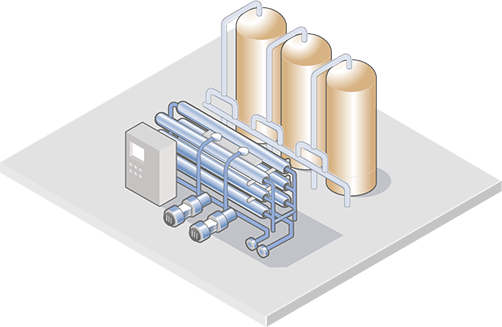Industrial Waste Water Treatment-- Eco-Friendly Solutions for Water Recycling
Key Strategies in Industrial Waste Water Treatment Procedures
The treatment of commercial wastewater is an essential element of environmental monitoring, including a range of strategies developed to alleviate the impact of impurities. Developments in innovations such as membrane filtering and advanced oxidation processes provide ingenious options for boosting therapy efficiency.
Physical Therapy Approaches
Just how properly can physical therapy approaches resolve the intricacies of commercial wastewater? Physical therapy methods play a critical role in the preliminary phases of wastewater monitoring, concentrating mostly on the elimination of solids and big particulates. Techniques such as filtration, flotation, and sedimentation are essential for reducing the focus of suspended solids, thus enhancing the efficiency of subsequent treatment processes.
Sedimentation entails the gravitational settling of solids, enabling for the splitting up of much heavier products from the wastewater. This technique is specifically efficient in clarifying water prior to organic or chemical treatments.
In addition, flotation approaches, which utilize air bubbles to raise put on hold solids to the surface for elimination, are effective in dealing with wastewater with high focus of fats, oils, and greases. On the whole, physical treatment methods work as a critical primary step in the extensive monitoring of industrial wastewater, guaranteeing that the lots on subsequent treatment phases is decreased and enhancing general therapy efficacy.
Chemical Treatment Methods
While physical treatment approaches lay the foundation for effective wastewater monitoring, chemical treatment techniques are crucial for attending to the much more intricate contaminants commonly located in commercial effluents. These methods utilize various chemical representatives to precipitate, counteract, or oxidize dangerous compounds, guaranteeing an extra thorough elimination of toxins.
One usual technique is coagulation and flocculation, where chemical coagulants such as light weight aluminum sulfate or ferric chloride are included in promote the aggregation of put on hold bits. This process improves solid-liquid separation, decreasing turbidity and enhancing water top quality. Additionally, neutralization procedures are utilized to change the pH of wastewater, utilizing bases or acids to counteract acidic or alkaline streams, respectively.
Oxidation-reduction responses play a critical function in derogatory organic impurities and pathogens. Chemical oxidants like ozone, hydrogen, or chlorine peroxide are used to break down intricate organic substances, making them less harmful or extra naturally degradable. Progressed oxidation processes (AOPs) combine several oxidation techniques to improve toxin removal efficiency.
Biological Treatment Procedures
The efficiency of wastewater therapy is considerably enhanced by organic treatment procedures, which harness the natural metabolic activities of microbes to break down natural issue and get rid of contaminants. Industrial Waste Water Treatment. These procedures mainly include aerobic and anaerobic food digestion, each customized for specific types of wastewater
Aerobic therapy procedures utilize oxygen to sustain microbial development, promoting the failure of organic contaminants right into co2 and water. Common approaches include triggered sludge systems, where oygenation storage tanks promote the blending of wastewater with microorganisms, and flowing filters, which urge biofilm development on media surface areas.
Conversely, anaerobic therapy procedures occur in the lack of oxygen, using anaerobic microorganisms to decompose natural issue, resulting in biogas manufacturing, a renewable energy source. Anaerobic digesters are usually used in commercial setups for this function, successfully reducing the quantity of sludge while producing useful biogas.
The selection of a biological treatment technique depends on wastewater attributes, therapy objectives, and governing requirements. The integration of biological processes in wastewater treatment not only enhances toxin elimination efficiency yet additionally promotes sustainability by lessening chemical use and sustaining resource healing.
Advanced Oxidation Processes

Usual AOP strategies consist of Fenton's photocatalysis, ozonation, and reagent. Fenton's reagent, a combination of hydrogen peroxide and ferrous iron, militarizes the formation of hydroxyl radicals, making it efficient for treating wastewater consisting of phenolic compounds and other stubborn materials. Ozonation makes use of ozone as an effective oxidant, qualified of breaking down a large range of natural contaminants while at the same time decontaminating the effluent. Photocatalysis employs light-activated catalysts, such as titanium dioxide, to boost oxidation responses and get rid of impurities.
AOPs supply several benefits, consisting of minimized sludge manufacturing and the capacity to deal with wastewater with high concentrations of natural pollutants. Nonetheless, the execution of AOPs needs cautious factor to consider of operational parameters and cost-effectiveness, guaranteeing that these advanced methods are appropriately integrated right into existing wastewater treatment systems.
Membrane Layer Filtering Technologies

Microfiltration is efficient for removing suspended microorganisms and solids, while ultrafiltration targets smaller organic molecules and infections. Nanofiltration links the space in between ultrafiltration and turn around osmosis, properly removing divalent ions and natural substances. Reverse osmosis provides the highest degree of purification, made use of mostly for desalination and removing mono-valent ions.
Membrane innovations supply countless benefits, consisting of reduced power consumption compared to traditional treatment methods, modular design for scalability, and the capacity for water recovery and reuse. Challenges such as membrane layer fouling and the requirement for regular upkeep have to be resolved to make certain system efficiency. Generally, membrane layer filtering technologies represent a vital part of modern industrial wastewater Clicking Here therapy approaches, advertising sustainability and resource preservation in water monitoring.
Final Thought
In conclusion, commercial wastewater therapy employs a varied array of methods, consisting of physical, chemical, organic, and advanced approaches. Continued developments in these techniques will additionally improve the effectiveness and efficiency of wastewater therapy click for info processes in industrial settings.
The therapy of commercial wastewater is a critical element of ecological management, involving a variety of strategies designed to alleviate the influence of contaminants.Exactly how properly can physical therapy methods attend to the intricacies of commercial wastewater?Advanced oxidation processes (AOPs) represent a sophisticated approach in industrial wastewater therapy, made to successfully weaken natural toxins that are commonly resistant to conventional therapy techniques (Industrial Waste Water Treatment).In conclusion, commercial wastewater therapy employs a varied range of techniques, including physical, chemical, biological, and advanced techniques. Proceeded advancements in these approaches will even more boost the performance and effectiveness of wastewater therapy processes in industrial setups